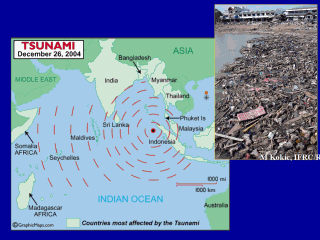| front |1 |2 |3 |4 |5 |6 |7 |8 |9 |10 |11 |12 |13 |14 |15 |16 |17 |18 |19 |20 |21 |22 |23 |24 |25 |26 |27 |28 |29 |30 |31 |32 |33 |34 |35 |36 |37 |38 |review |
 |
On December
26, 2004, an earthquake off the coast of Sumatra in the Indian Ocean
triggered a widespread tsunami that resulted in one of the worst natural
disasters in modern history (http://www.usaid.gov).
Massive casualties that occurred were the result of the direct impact of the
tsunami and were mostly due to drowning or severe trauma from debris.
Numerous people were injured, in need of medical or surgical attention and
many survivors were displaced due to damage or destruction of dwellings and
massive disruption of infrastructure throughout the affected region. In the days and weeks following such a devastating disaster, the threat of infectious disease outbreaks is high. The goal of emergency health is to prevent epidemics and improve deteriorating health conditions among the population affected. The highest priority is directed towards diseases that could potentially cause excess mortality and morbidity due to the disaster. Immediately following the tsunami disaster, the World Health Organization (WHO) Health Action in Crisis Network was activated to support disease surveillance, advise on outbreak situations, support needs assessments and restoration of public health infrastructure, and mobilize resources and supplies such as drugs and water purification tablets (http://www.who.int). |